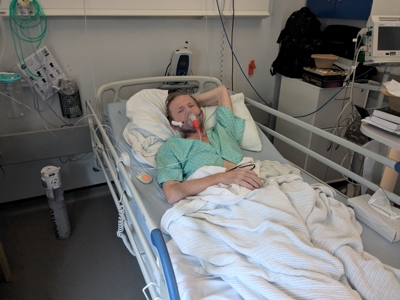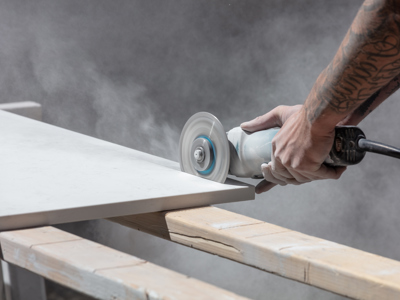
Lung Cancer Awareness month: Rise in Silicosis cases
In Lung Cancer Awareness month, Andrew Cooper explains the rise in silicosis cases being seen by Leigh Day's industrial disease team
Posted on 14 November 2024
November is Lung Cancer Awareness Month, which offers the opportunity to raise awareness of the importance of lung health and cancer awareness. There are several factors which can increase the risk of lung cancer, and one such risk of is occupational exposure to hazardous dusts, including silica dust.
There have recently been reports in the media of an increase in the number of people being diagnosed with silicosis, a type of lung disease, arising from exposure to silica dust.
Leigh Day has started to represent a ‘new wave’ of these workers, who were exposed to silica dust whilst cutting or drilling artificial stone, also known as engineered stone, which is used in quartz kitchen worktops. This has led to an increase in the diagnoses of silicosis across the country.
In conjunction with Roy Castle Lung Cancer Foundation, we explore the emerging rise of silicosis cases and how raising awareness of the dangers of cutting engineered stone can promote lung health in the workplace and reduce the associated risks of lung cancer.
Roy Castle Lung Cancer Foundation chief executive, Paula Chadwick says:
“We’re so grateful to Leigh Day for raising awareness of this potential risk of lung cancer so employers can protect workers and put appropriate safety measures in place to minimise exposure. We join its calls for a public campaign to improve awareness and ensure people working with the material are properly protected.
“Lung cancer is a widely misunderstood, with many people still of the belief that you must smoke to get the disease. However, there are many different causes of lung cancer. That’s why, this lung cancer awareness month, we’re calling to Let Go of the Labels to help people get diagnosed sooner.
“We want everyone to stop thinking about lung cancer in terms of smoking, or not smoking, and instead simply recognise that, just with all cancers, it’s a disease that can affect anyone.”
What is silicosis?
Silicosis is an irreversible lung condition caused by inhaling large amounts of silica dust over a prolonged period. Silica is a common, natural material found in stones, rocks, clay, and sand as well as products such as bricks, tiles, concrete, and some plastic composites. Once inside the lungs, the silica dust particles are attacked by the immune system which causes inflammation and scarring of the lung tissue.
The workers we have represented have been exposed to silica dust through cutting kitchen worktops and have developed an acute form of silicosis. This causes significant shortness of breath and severe disability, with lung transplantation often being the only potential treatment. In the worst cases it can be fatal.
What is engineered stone?
In recent years engineered stone has become a popular choice for kitchen worktops – these are often called quartz worktops. Unlike natural stone products, such as marble and granite, quartz worktops are made by compressing and compacting raw materials together into slabs, which are then heated at high temperatures. It has been reported that quartz kitchen worktops contain over 90% silica, whereas granite contains approximately half the silica content.
While quartz worktops are a cheaper alternative for the consumer, they have the potential to pose a greater risk to the workers who cut, grind and polish the slabs before they are installed, due to the higher levels of fine silica dust they may be exposed to if they do not have the correct protective equipment.
Who is at risk of silicosis?
The Leigh Day Industrial Disease Team is acting for a number of workers who have developed silicosis due to cutting engineered stone without the appropriate protective equipment.
Our clients have described appalling working conditions, where they use handheld electric grinders to cut and polish the stone in a dust-filled room with no windows, no effective dust extraction equipment or respirators. The evidence we have gathered so far points to a growing problem with small companies operating without regard to appropriate health and safety practices. However, we fear this issue may become more widespread in the future and that cases may arise from larger operations and other kitchen fitting companies.
Leigh Day has set up a dedicated team specialising in these claims. We are working alongside leading medical experts to ensure we are at the forefront of medical knowledge for our clients.
The rise of cases in the UK and around the world
In Australia, there has been a rise in silicosis cases with reports showing that as of May 2022 there have been 579 cases due to engineered stone. This number is likely to be higher due to a lack of publicly available data in some jurisdictions. Earlier this year, the Australian government banned the use of engineered stone as a result.
In California, steps have been taken to tighten the regulations covering engineered stone. It is reported by the LA Times that there have been 100 recorded cases of silicosis relating to those cutting worktops in the state since 2019. At least 10 people are reported to have died as a result.
In August 2024, a report by a leading lung disease expert warned of the emergence of silicosis and underlined the need for urgent action to better protect workers.
The paper’s lead author, Dr Johanna Feary, a consultant in occupational lung disease at Royal Brompton Hospital and senior clinical research fellow at the National Heart and Lung Institute at Imperial College London, has treated some of the first patients in the UK to be diagnosed with silicosis caused by manufacturing and cutting kitchen worktops.
The paper, published in the BMJ journal Thorax, reports the first eight cases in the UK of silicosis due cutting artificial stone. It confirms that cases in the UK are similar to others reported from abroad, where workers develop a more severe and progressive form of silicosis. The paper found that the new form of silicosis is characterised by a much shorter duration of exposure to silica dust than previously seen. All the patients in the study were young men, with an average age of 34. A number of those affected have died or been referred for lung transplant assessment.
The number of cases of silicosis due to artificial stone worldwide is not known and is likely to be underestimated. Based on global experience and drawing from data in Australia where artificial stone has been recently banned, the number of UK cases is likely to increase significantly in the coming years.
How can workers be protected from the dangers of silicosis?
The associated danger between dust and lung disease has been known for over a century. Whilst health and safety protection in the UK has improved over this time, workers are still being exposed to harmful dusts and are developing silicosis regardless.
In the UK, the House of Lords debated the issue in January 2024 and the (then Conservative) government confirmed that the Health and Safety Executive (HSE) are not currently considering banning the use of engineered stone, because there are regulations in place to protect workers which are enforced by the HSE.
In October 2024 it was reported that the HSE has prepared draft guidance for working with engineered stone and is seeking feedback from the Worktop Fabricators Federation (HSE to draft new guidelines around engineered stone (shponline.co.uk)
An HSE spokesperson said:
“Great Britain has a robust and well-established regulatory framework in place to protect workers from the health risks associated with exposure to hazardous substances.
We continue to work with industry to raise awareness of managing the risks of exposure to respirable crystalline silica.
As part of this engagement, we are consulting with industry on best practice guidelines and we met with manufacturers of stone, on Monday 7 October 2024, to discuss practical solutions to tackle this shared issue. We will also hold further workshops with other stakeholders in the supply chain, with the aim of securing coordinated and collaborative impact on the causes of unsafe levels of worker exposure.”
These steps from the HSE are welcome, however a recent report by the trade union Prospect highlighted that prolonged funding cuts to the HSE means that it struggles to carry out its inspection and investigation activities, raising serious concerns about its ability to monitor and react to the growing threat posed to kitchen worktops workers.
As above, Leigh Day’s experience to date suggests that those affected have worked for small companies operating without regard to appropriate health and safety practices. These companies may not be engaged with the Worktop Fabricators Federation or other industry groups, and therefore ensuring they comply with their health and safety obligations is likely to require targeted and comprehensive monitoring. We consider there should be mandatory attendance of the HSE to businesses using engineered stone and greater funding for the HSE to deal with employers with poor practices.
Promoting lung health in the workplace
There needs to be greater understanding of the dangers of working with engineered stone, as part of a wider drive to raise awareness of the importance of protecting and promoting lung health in the workplace.
Patients who develop silicosis are at greater risk of developing other conditions, including lung cancer, and it is essential that employers and workers are fully aware of the risks and that appropriate safety measures are put in place.
We encourage the HSE to launch a public campaign to ensure there is better awareness of the dangers of engineered stone and better protection for people working with the material. We consider that the Government should look closely at this matter to ensure that businesses put the correct protections in place and that the HSE can take swift action against those that break the rules to ensure the safety of our workforce.

Stone worker with terminal silicosis says cutting quartz kitchen worktops in unsafe working conditions has cost him his life
A stone worker in hospital with terminal silicosis says he developed the disease after inhaling dust while cutting engineered stone, known as quartz, kitchen worktops in unsafe working conditions.

Lawyers representing growing number of engineered stone workers with silicosis say tougher safety measures are urgently needed
Lawyers at Leigh Day, who represent a growing number of workers diagnosed with silicosis after manufacturing engineered stone kitchen worktops, say tougher safety measures are urgently needed to stop the rise in the deadly disease.


